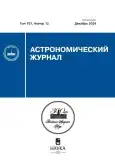Search for pulsars with periods of more than two seconds at declinations from +21◦ to +42◦
- 作者: Tyul’bashev S.A.1, Tyul’basheva G.E.2
-
隶属关系:
- Lebedev Physical Institute
- Institute of Mathematical Problems of Biology RAS (IMPB RAS), branch of Keldysh Institute of Applied Mathematics of Russian Academy of Sciences
- 期: 卷 101, 编号 12 (2024)
- 页面: 1095-1106
- 栏目: Articles
- URL: https://rjsvd.com/0004-6299/article/view/647689
- DOI: https://doi.org/10.31857/S0004629924120074
- EDN: https://elibrary.ru/ICKCOZ
- ID: 647689
如何引用文章
详细
The search for long period transients with periods (P) from 2 to 90 s was carried out in daily observations conducted in a area 6300 sq. deg.. The data was obtained on a Large Phased Array (LPA) at a frequency of 111 MHz. Periodograms calculated using the Fast Folding Algorithm (FFA) were used for the search. To increase the sensitivity, the periodograms obtained in different observation sessions were added. Of the 14 known pulsars that entered the study area, having periods P > 2 c and dispersion measures (DM) less than 200 pc/cm3, 9 were detected. Two new pulsars were found. The average profiles of pulsars are obtained and estimates of their flux density are given. The discovered pulsar J1951+28, with a period of P = 7.3342 s and DM = 3.5 pc/cm3, turned out to be one of the closest pulsars to the Sun. The absence of new long period transients (pulsars or white dwarf) with periods of tens of seconds with the achieved sensitivity of searching for 1 mJy outside the galactic plane indicates a low probability of the existence of pulsars of neutron stars with extremely long periods. Most likely, the recently found sources of periodic radiation with periods from a minute to tens of minutes are white dwarfs pulsars.
关键词
全文:
作者简介
S. Tyul’bashev
Lebedev Physical Institute
编辑信件的主要联系方式.
Email: serg@prao.ru
Astro-Space center, Pushchino radio astronomy observatory
俄罗斯联邦, PushchinoG. Tyul’basheva
Institute of Mathematical Problems of Biology RAS (IMPB RAS), branch of Keldysh Institute of Applied Mathematics of Russian Academy of Sciences
Email: serg@prao.ru
俄罗斯联邦, Pushchino
参考
- A. Hewish, S. J. Bell, J.D.H. Pilkington, P. F. Scott, and R. A. Collins, Nature 217(5130), 709 (1968).
- R.V.E. Lovelace and H. D. Craft, Nature 220(5170), 875 (1968).
- D.H. Staelin, IEEE Proceedings 57, 724; National Radio Astron. Observ., Green Bank, Ser. A., No. 111 (1969).
- V. Morello, E. D. Barr, B. W. Stappers, E. F. Keane, and A. G. Lyne, Monthly Not. Roy. Astron. Soc. 497(4), 4654 (2020).
- A.D. Cameron, E. D. Barr, D. J. Champion, M. Kramer, and W. W. Zhu, Monthly Not. Roy. Astron. Soc. 468(2), 1994 (2017).
- E. Parent, V. M. Kaspi, S. M. Ransom, M. Krasteva, et al., 861(1), id. 44 (2018).
- S. Singh, J. Roy, B. Bhattacharyya, U. Panda, B. W. Stappers, and M. A. McLaughlin, 944(1), id. 54 (2023).
- S.A. Tyul’bashev, G. E. Tyul’basheva, M. A. Kitaeva, I. L. Ovchinnikov, V. V. Oreshko, and S. V. Logvinenko, Monthly Not. Roy. Astron. Soc. 528(2), 2220 (2024).
- R.N. Manchester, G. B. Hobbs, A. Teoh, and M. Hobbs, Astron. J. 129(4), 1993 (2005).
- M. Caleb, I. Heywood, K. Rajwade, M. Malenta, et al., Nature Astronomy 6, 828 (2022).
- C.M. Tan, C. G. Bassa, S. Cooper, T. J. Dijkema, et al., 866(1), id. 54 (2018).
- N. Hurley-Walker, X. Zhang, A. Bahramian, S. J. McSweeney, et al., Nature 601(7894), 526 (2022).
- N. Hurley-Walker, N. Rea, S. J. McSweeney, B. W. Meyers, et al., Nature 619(7970), 487 (2023).
- N. Rea, N. Hurley-Walker, C. Pardo-Araujo, M. Ronchi, et al., 961(2), id. 214 (2024).
- S.A. Tyul’bashev, V. S. Tyul’bashev, V. V. Oreshko, and S. V. Logvinenko, Astron. Rep. 60(2), 220 (2016).
- V.I. Shishov, I. V. Chashei, V. V. Oreshko, S. V. Logvinenko, et al., Astron. Rep. 60(12), 1067 (2016).
- S.A. Tyul’bashev, M. A. Kitaeva, and G. E. Tyul’basheva, Monthly Not. Roy. Astron. Soc. 517(1), 1112 (2022).
- S.A. Tyul’bashev, M. A. Kitaeva, V. S. Tyul’bashev, V. M. Malofeev, and G. E. Tyul’basheva, Astron. Rep. 64(6), 526 (2020).
- S.A. Tyul’bashev, M. A. Kitaeva, E. A. Brylyakova, V. S. Tyul’bashev, and G. E. Tyul’basheva, Astron. Letters 49(10), 533 (2023).
- S. Sanidas, S. Cooper, C. G. Bassa, J.W.T. Hessels, et al., Astron. and Astrophys. 626, id. A104 (2019).
- A.J. Turtle and J. E. Baldwin, Monthly Not. Roy. Astron. Soc. 124, 459 (1962).
- A.V. Bilous, V. I. Kondratiev, M. Kramer, E. F. Keane, et al., Astron. and Astrophys. 591, id. A134 (2016).
- V.M. Malofeev, O. I. Malov, and N. V. Shchegoleva, Astron. Rep. 44(7), 436 (2000).
- J.M. Yao, R. N. Manchester, and N. Wang, 835(1), id. 29 (2017).
- R. Lopes de Oliveira, A. Bruch, C. V. Rodrigues, A. S. Oliveira, and K. Mukai, Astrophys. J. Letters 898(2), id. L40 (2020).
- I. Pelisoli, T. R. Marsh, V. S. Dhillon, E. Breedt, et al., Monthly Not. Roy. Astron. Soc. 509, L31 (2022).
- I. Pelisoli, T. R. Marsh, D.A.H. Buckley, I. Heywood, et al., Nature Astron. 7, 931 (2023).
- A.A. Lutovinov, S. S. Tsygankov, I. A. Mereminskiy, S. V. Molkov, et al., Astron. and Astrophys. 661, id. A28 (2022).
- K. Chen and M. Ruderman, 402, 264 (1993).
- O.C. de Jager, Astrophys. J. Suppl. 90, 775 (1994).
- N.R. Ikhsanov, Astron. and Astrophys. 338, 521 (1998).
- S. Singh, J. Roy, U. Panda, B. Bhattacharyya, V. Morello, B. W. Stappers, P. S. Ray, and M. A. McLaughlin, 934(2), id. 138 (2022).
- J. Wongphechauxsorn, D. J. Champion, M. Bailes, V. Balakrishnan, et al., Monthly Not. Roy. Astron. Soc. 527(2), 3208 (2024).
- B. Bhattacharyya, S. Cooper, M. Malenta, J. Roy, et al., 817(2), id. 130 (2016).
- M.J. Keith, A. Jameson, W. van Straten, M. Bailes, et al., Monthly Not. Roy. Astron. Soc. 409(2), 619 (2010).
- O. Maron, J. Kijak, M. Kramer, and R. Wielebinski, Astron. and Astrophys. Suppl. Ser. 147, 195 (2000). Astrophys. 333, 956 (1998).
- B.D.S. Budi and H. L. Malasan, Preprint SSRN № 4620956 (2023).
补充文件













